Japanese Pilgrimage in Kagawa
2014年05月19日
The pilgrims’ route, or ‘henro’ pilgrimage in the Japanese island of Shikoku is and arduous walk of some 1,200 km taking anywhere between one or even two months to complete. The 88 temples of the Shingon or esoteric school of Buddhism dotted around this island and founded by the much-loved ‘Kukai’ as he is popularly called, or Kobo Daishi is becoming a world-class attraction.

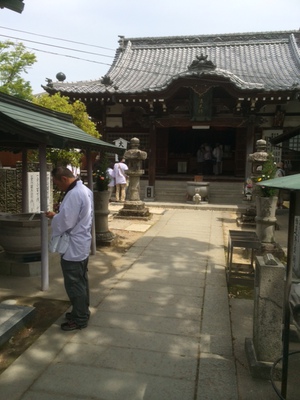
The purpose of the pilgrimage taken by the faithful can be for any number of reasons; asceticism, healing, salvation, atonement & repentance. Or even just general wellbeing and exercise. It all depends upon the depth of belief and commitment to the faith. Stories of miraculous healings are legion. So are the devotees who make this journey a focal point of spiritual life especially towards the end of it. I’d like to think that one day I’ll do it myself as a few friends have already.


The circumambulation by foot around the island is expected of believers at least once in their lifetime but these days most undertake a bus trip instead of austerities on foot. A few ride bicycles, some even do the pilgrimage by taxi.


In these last twenty years or so, there have been any number if books about this pilgrimage and sad to say, they are pretty much all knock offs for profits & sales by people without much deep knowledge of what this is all about. I suggest reading the dated but beautiful book by Oliver Statler ‘Japanese Pilgrimage’ as it’s the standard by which all the others can be judged.


Statler’s book is the best and I can’t stress this enough particularly after reading a couple of the others. It will give you a deeper understanding of what is going on as will the book ‘Kukai Major Works’ by Yoshihito Hakeda (translated into English) The beloved Kobo Daishi Kukai the founder of Shingon buddhism, saint, miracle worker, engineer, is by far the most influential force in Japanese religious and societal beliefs. Yet sadly most of us in the west have never heard of him.

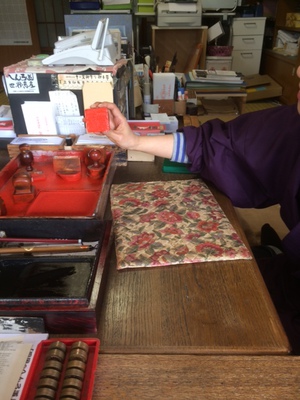
I took these photos at the 83 Ichiyomiyaji temple on the outskirts of Takamatsu at a town named Enza and we can see pilgrims in their traditional white clothes. The same ones many will wear to be cremated. The stamps are from the temples in official recognition they have travelled the route and the ink writings on the clothes are religious formulae of the faith.


Other bloggers in Takamatsu of interest:
http://cathy.ashita-sanuki.jp
http://ogijima.com
http://ww8.tiki.ne.jp/~tmath/home/
Where we are:
http://wikitravel.org/en/Takamatsu
http://www.city.takamatsu.kagawa.jp/english/
http://www.my-kagawa.jp/special/visitor/kanko/index.htm
http://www.i-pal.or.jp/profile/topics/kagawas-welcome-card.html


The purpose of the pilgrimage taken by the faithful can be for any number of reasons; asceticism, healing, salvation, atonement & repentance. Or even just general wellbeing and exercise. It all depends upon the depth of belief and commitment to the faith. Stories of miraculous healings are legion. So are the devotees who make this journey a focal point of spiritual life especially towards the end of it. I’d like to think that one day I’ll do it myself as a few friends have already.


The circumambulation by foot around the island is expected of believers at least once in their lifetime but these days most undertake a bus trip instead of austerities on foot. A few ride bicycles, some even do the pilgrimage by taxi.
In these last twenty years or so, there have been any number if books about this pilgrimage and sad to say, they are pretty much all knock offs for profits & sales by people without much deep knowledge of what this is all about. I suggest reading the dated but beautiful book by Oliver Statler ‘Japanese Pilgrimage’ as it’s the standard by which all the others can be judged.


Statler’s book is the best and I can’t stress this enough particularly after reading a couple of the others. It will give you a deeper understanding of what is going on as will the book ‘Kukai Major Works’ by Yoshihito Hakeda (translated into English) The beloved Kobo Daishi Kukai the founder of Shingon buddhism, saint, miracle worker, engineer, is by far the most influential force in Japanese religious and societal beliefs. Yet sadly most of us in the west have never heard of him.

I took these photos at the 83 Ichiyomiyaji temple on the outskirts of Takamatsu at a town named Enza and we can see pilgrims in their traditional white clothes. The same ones many will wear to be cremated. The stamps are from the temples in official recognition they have travelled the route and the ink writings on the clothes are religious formulae of the faith.
Other bloggers in Takamatsu of interest:
http://cathy.ashita-sanuki.jp
http://ogijima.com
http://ww8.tiki.ne.jp/~tmath/home/
Where we are:
http://wikitravel.org/en/Takamatsu
http://www.city.takamatsu.kagawa.jp/english/
http://www.my-kagawa.jp/special/visitor/kanko/index.htm
http://www.i-pal.or.jp/profile/topics/kagawas-welcome-card.html
Posted by pat at
23:38
Seto Inland Sea Folk History Museum
2014年05月17日
This is one of the most striking and beautiful buildings I have seen. Nestled near the summit of Go Shiki Dai mountain, close to our Takamatsu city and it is well worth a visit if you’re in the Takamatsu area.

The design is a beautiful combination of the new and the old. Buttress like and built on a hillside with a heavily fortified appearance, dark grey stone is the predominant material of the cluster of buildings on multi levels that comprises the museum. The museum complex looks out across the Seto Inland Sea and its long history to which it was dedicated. Opened in 1973, the building was awarded the Japan Architect Society Award. No surprise really as it’s world class and a winner.

Staffed by many volunteers, the museum offers lectures and demonstrations on a variety of maritime topics and next June 14th (Saturday from 1:30~3:00) there will be a demonstration event about salt and its long history with this region.

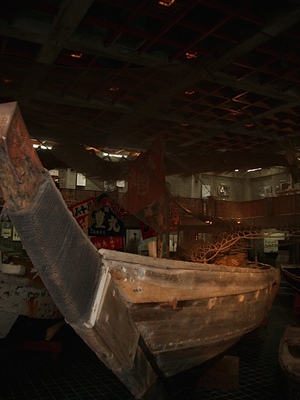
With the faint smell of salt from the sea the environment is perfect. The museum is cooled naturally in the summer by the beautiful stone walls. The outside parapet like low walls are well laid out with seasonal flowers and well tended.
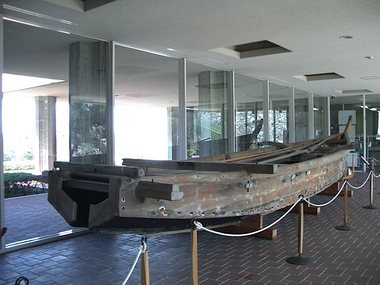
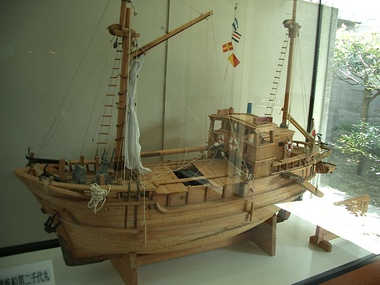
On the inside are many wooden vessels spanning the different eras and the tools used to make them. Of particular interest to me was a display of the efforts to keep the waterways free from plastics. Given that are seas everywhere are choking with plastic junk it’s good to see they are making a strong effort to educate people, especially the young, to realize that the sea is important.
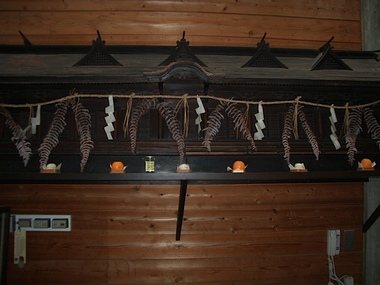
The one drawback is access is limited but well worth the visit. A car is the best method and the map is on the site’s link below. It takes about 25 minutes from Takamatsu’s Central JR rail station. A taxi fare will be about 4,500 yen and unfortunately there doesn’t seem to be a bus route.
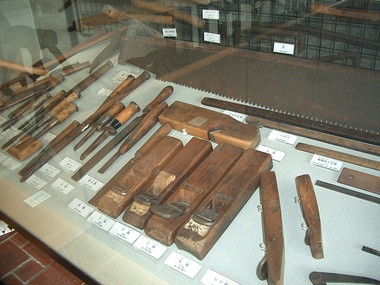

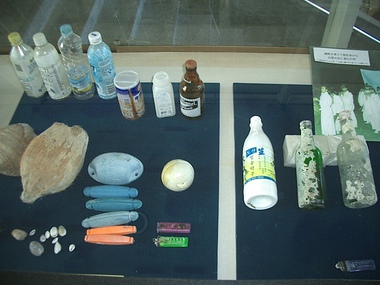
Open from 9:00~5:00 with last visitors admitted at 4:30.
Closed on Mondays and please check the site’s calendar for the open days.
1412-2 Tarumi-cho, Takamatsu, Kagawa Prefecture 761-8001, Japan
+81 87-881-4707
Website: http://www.pref.kagawa.jp/setorekishi/
E-mail: setorekishi@pref.kagawa.lg.jp
http://www.city.takamatsu.kagawa.jp/12754.html
Other bloggers in Takamatsu of interest:
http://cathy.ashita-sanuki.jp
http://ogijima.com
http://ww8.tiki.ne.jp/~tmath/home/
Where we are:
http://wikitravel.org/en/Takamatsu
http://www.city.takamatsu.kagawa.jp/english/
http://www.my-kagawa.jp/special/visitor/kanko/index.htm
http://www.i-pal.or.jp/profile/topics/kagawas-welcome-card.html

The design is a beautiful combination of the new and the old. Buttress like and built on a hillside with a heavily fortified appearance, dark grey stone is the predominant material of the cluster of buildings on multi levels that comprises the museum. The museum complex looks out across the Seto Inland Sea and its long history to which it was dedicated. Opened in 1973, the building was awarded the Japan Architect Society Award. No surprise really as it’s world class and a winner.

Staffed by many volunteers, the museum offers lectures and demonstrations on a variety of maritime topics and next June 14th (Saturday from 1:30~3:00) there will be a demonstration event about salt and its long history with this region.


With the faint smell of salt from the sea the environment is perfect. The museum is cooled naturally in the summer by the beautiful stone walls. The outside parapet like low walls are well laid out with seasonal flowers and well tended.


On the inside are many wooden vessels spanning the different eras and the tools used to make them. Of particular interest to me was a display of the efforts to keep the waterways free from plastics. Given that are seas everywhere are choking with plastic junk it’s good to see they are making a strong effort to educate people, especially the young, to realize that the sea is important.

The one drawback is access is limited but well worth the visit. A car is the best method and the map is on the site’s link below. It takes about 25 minutes from Takamatsu’s Central JR rail station. A taxi fare will be about 4,500 yen and unfortunately there doesn’t seem to be a bus route.



Open from 9:00~5:00 with last visitors admitted at 4:30.
Closed on Mondays and please check the site’s calendar for the open days.
1412-2 Tarumi-cho, Takamatsu, Kagawa Prefecture 761-8001, Japan
+81 87-881-4707
Website: http://www.pref.kagawa.jp/setorekishi/
E-mail: setorekishi@pref.kagawa.lg.jp
http://www.city.takamatsu.kagawa.jp/12754.html
Other bloggers in Takamatsu of interest:
http://cathy.ashita-sanuki.jp
http://ogijima.com
http://ww8.tiki.ne.jp/~tmath/home/
Where we are:
http://wikitravel.org/en/Takamatsu
http://www.city.takamatsu.kagawa.jp/english/
http://www.my-kagawa.jp/special/visitor/kanko/index.htm
http://www.i-pal.or.jp/profile/topics/kagawas-welcome-card.html
Posted by pat at
22:06




